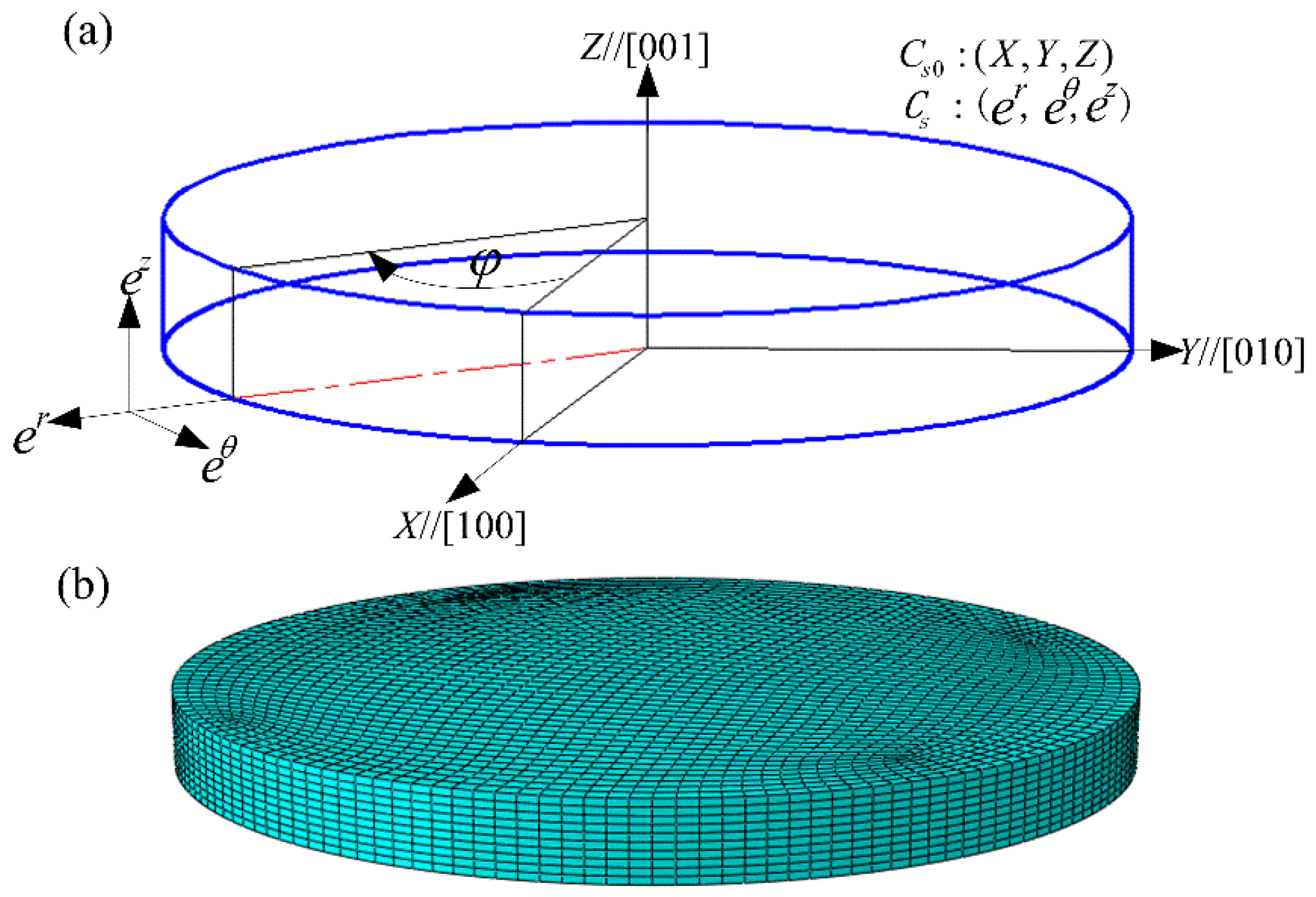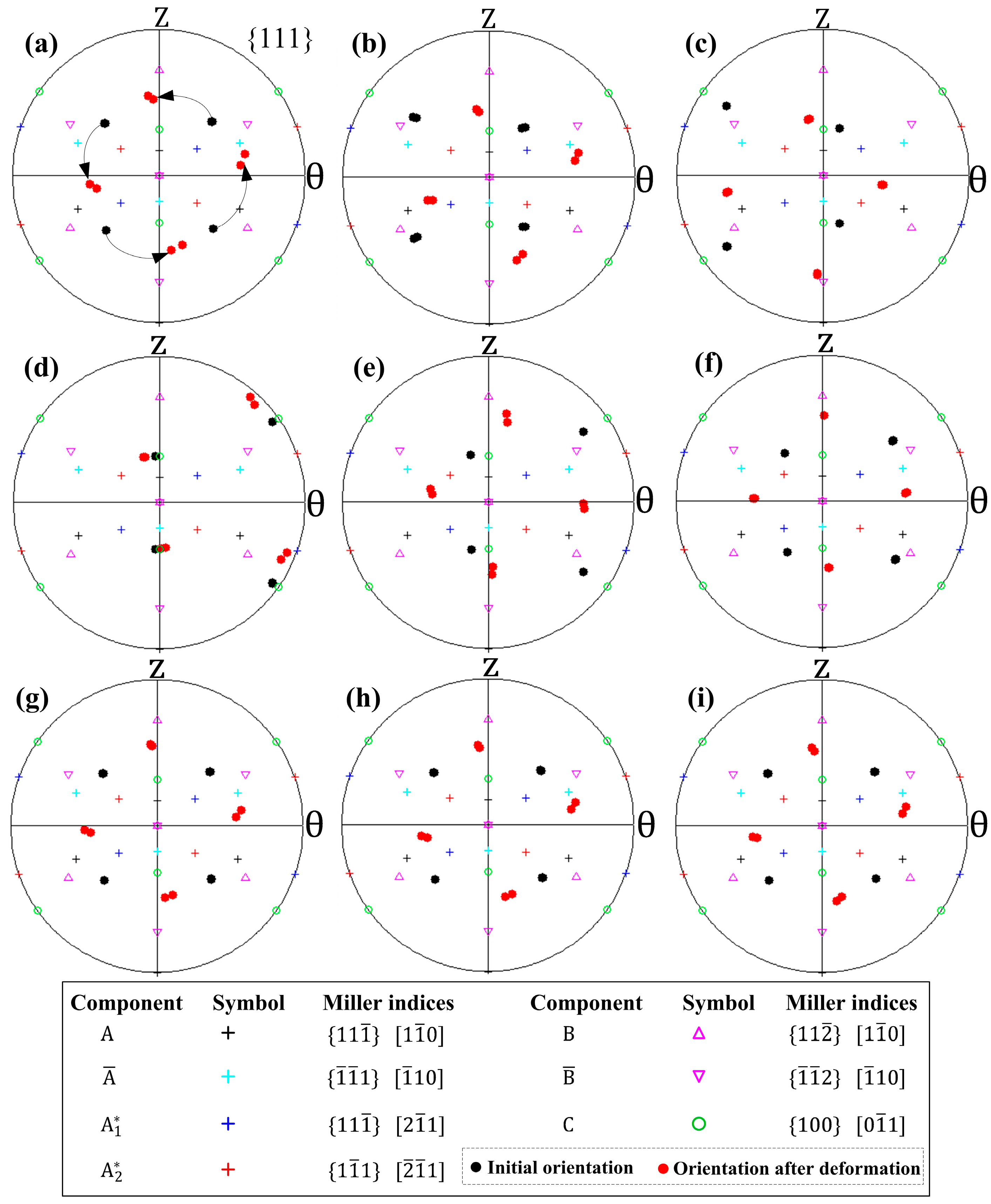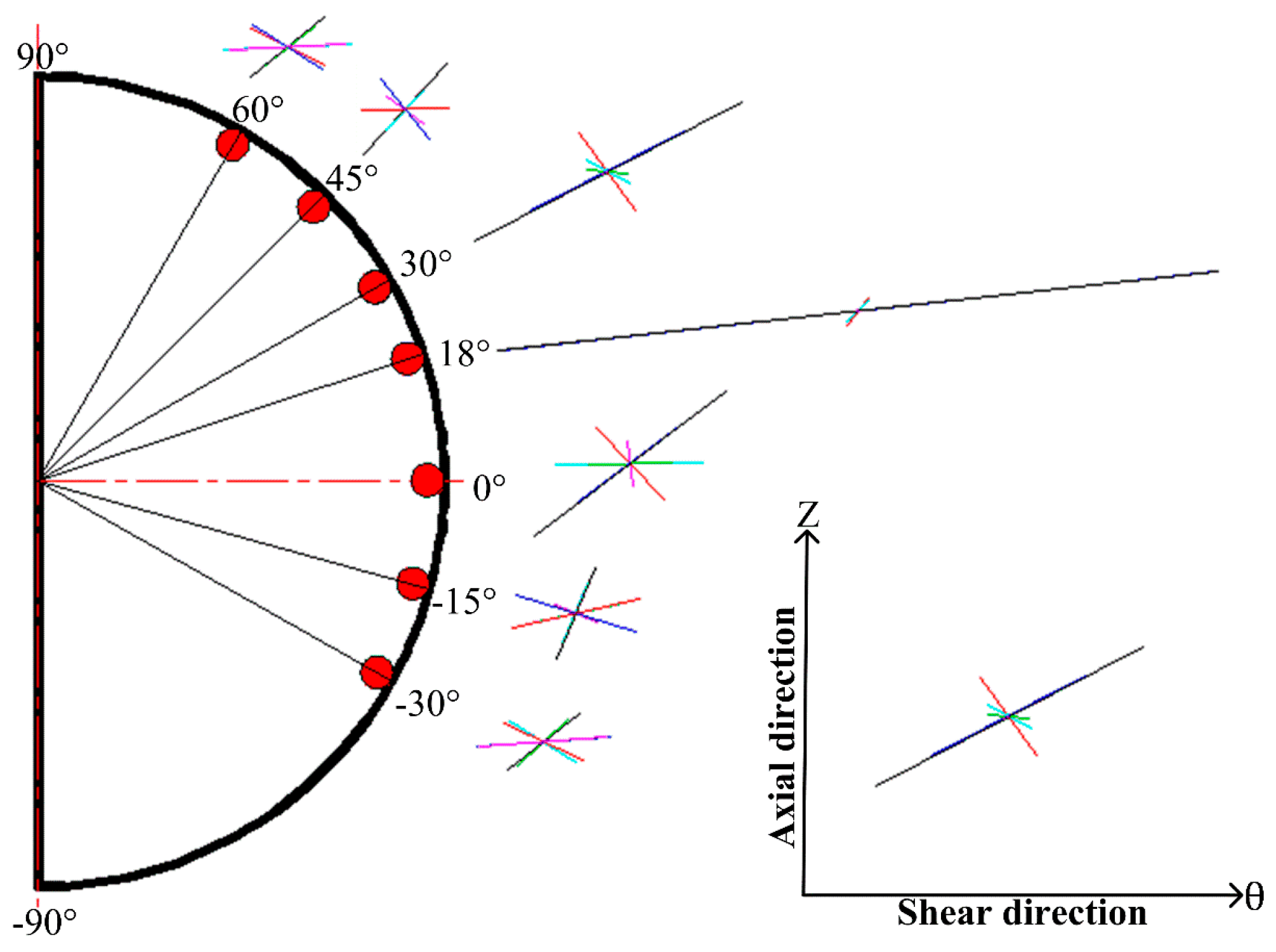Study of Anisotropic Plastic Behavior in High Pressure Torsion of Aluminum Single Crystal by Crystal Plasticity Finite Element Method
Abstract
:1. Introduction
2. CPFEM Simulation Procedure
2.1. Crystal Plasticity Constitutive Model
2.2. Finite Element Implementation
3. Results
3.1. Distributions of Equivalent Plastic Strain and Mises Stress
3.2. Texture Development Along the Tangential Direction
3.3. Lattice Rotation and Slip Trace along the Tangential Direction
4. Discussion
5. Conclusions
- The predicted equivalent plastic strain and Mises stress are directionally dependent along the sample circumference, and the development of a four-fold symmetry pattern is found on the sample surface.
- The R-axis lattice rotations, slip traces, and the resulting crystallographic orientations change significantly along the circumferential direction, and also develop the feature of four-fold symmetry.
- The dominant slip and multi-slip conditions are revealed along the sample circumference. It has been found that the differences in slip system activation contribute significantly to the anisotropic plastic behavior of single crystal during the HPT process.
Acknowledgments
Author Contributions
Conflicts of Interest
References
- Langdon, T.G. Twenty-five years of ultrafine-grained materials: Achieving exceptional properties through grain refinement. Acta Mater. 2013, 61, 7035–7059. [Google Scholar] [CrossRef]
- Estrin, Y.; Vinogradov, A. Extreme grain refinement by severe plastic deformation: A wealth of challenging science. Acta Mater. 2013, 61, 782–817. [Google Scholar] [CrossRef]
- Bridgman, P.W. On torsion combined with compression. J. Appl. Phys. 1943, 14, 273. [Google Scholar] [CrossRef]
- Deng, G.; Lu, C.; Su, L.; Tieu, A.K.; Li, J.; Liu, M.; Zhu, H.; Liu, X. Influence of outer corner angle (OCA) on the plastic deformation and texture evolution in equal channel angular pressing. Comput. Mater. Sci. 2014, 81, 79–88. [Google Scholar] [CrossRef]
- Su, L.; Lu, C.; Deng, G.; Tieu, A.K.; Sun, X. Microstructure and mechanical properties of 1050/6061 laminated composite processed by accumulative roll bonding. Rev. Adv. Mater. Sci. 2013, 33, 33–37. [Google Scholar]
- Zhilyaev, A.; Langdon, T. Using high-pressure torsion for metal processing: Fundamentals and applications. Prog. Mater. Sci. 2008, 53, 893–979. [Google Scholar] [CrossRef]
- Edalati, K.; Horita, Z. A review on high-pressure torsion (HPT) from 1935 to 1988. Mater. Sci. Eng. A 2015, 652, 325–352. [Google Scholar] [CrossRef]
- Edalati, K.; Horita, Z. High-pressure torsion of pure metals: Influence of atomic bond parameters and stacking fault energy on grain size and correlation with hardness. Acta Mater. 2011, 59, 6831–6836. [Google Scholar] [CrossRef]
- Valiev, R.Z.; Zhilyaev, A.P.; Langdon, T.G. Hpt processing of metals, alloys, and composites. In Bulk Nanostructured Materials; John Wiley & Sons, Inc.: Hoboken, NJ, USA, 2013; pp. 88–151. [Google Scholar]
- Astafurova, E.G.; Tukeeva, M.S.; Maier, G.G.; Melnikov, E.V.; Maier, H.J. Microstructure and mechanical response of single-crystalline high-manganese austenitic steels under high-pressure torsion: The effect of stacking-fault energy. Mater. Sci. Eng. A 2014, 604, 166–175. [Google Scholar] [CrossRef]
- Khlebnikova, Y.V.; Egorova, L.Y.; Pilyugin, V.P.; Suaridze, T.R.; Patselov, A.M. Evolution of the structure of an α-titanium single crystal during high-pressure torsion. Tech. Phys. 2015, 60, 1005–1013. [Google Scholar] [CrossRef]
- Solov’eva, Y.V.; Pilyugin, V.P.; Starenchenko, S.V.; Tolmachev, T.P.; Starenchenko, V.A. Structure and mechanical properties of ni3ge single crystals under severe plastic deformation and heating. Bull. Russ. Acad. Sci. Phys. 2017, 81, 311–314. [Google Scholar] [CrossRef]
- Kashihara, K.; Tsujimoto, Y.; Terada, D.; Tsuji, N. Texture evolution in {112} <111> aluminum single crystals processed by severe plastic deformation. Mater. Charact. 2013, 75, 129–137. [Google Scholar] [CrossRef]
- Smirnova, N.A.; Levit, V.I.; Pilyugin, V.I.; Kuznetsov, R.I.; Davydova, L.S.; Sazonova, V.A. Evolution of structure of FCC Single crystals during strong plastic deformation. Phys. Met. Metallogr. 1986, 61, 127–134. [Google Scholar]
- Smirnova, N.A.; Levit, V.I.; Degtyarev, M.V.; Gundyrev, V.M.; Pilyugin, V.P.; Davydova, L.S. Development of orientational instability in FCC Single crystals at high degrees of plastic deformation. Phys. Met. Metallogr. 1988, 65, 141–151. [Google Scholar]
- Hafok, M.; Pippan, R. High-pressure torsion applied to nickel single crystals. Philos. Mag. 2008, 88, 1857–1877. [Google Scholar] [CrossRef]
- Pippan, R.; Scheriau, S.; Taylor, A.; Hafok, M.; Hohenwarter, A.; Bachmaier, A. Saturation of fragmentation during severe plastic deformation. Annu. Rev. Mater. Res. 2010, 40, 319–343. [Google Scholar] [CrossRef]
- Méric, L.; Cailletaud, G. Single crystal modeling for structural calculations: Part 2—Finite element implementation. Appl. Mech. Mater. 1991, 113, 171–182. [Google Scholar] [CrossRef]
- Nouailhas, D.; Cailletaud, G. Tension-torsion behavior of single-crystal superalloys: Experiment and finite element analysis. Int. J. Plast. 1995, 11, 451–470. [Google Scholar] [CrossRef]
- Kaluza, M.; Le, K.C. On torsion of a single crystal rod. Int. J. Plast. 2011, 27, 460–469. [Google Scholar] [CrossRef]
- Le, K.C.; Piao, Y. Distribution of dislocations in twisted bars. Int. J. Plast. 2016, 83, 110–125. [Google Scholar] [CrossRef]
- Wei, P.; Lu, C.; Tieu, K.; Su, L.; Deng, G.; Huang, W. A study on the texture evolution mechanism of nickel single crystal deformed by high pressure torsion. Mater. Sci. Eng. A 2017, 684, 239–248. [Google Scholar] [CrossRef]
- Wenk, H.R.; Van Houtte, P. Texture and anisotropy. Rep. Prog. Phys. 2004, 67, 1367–1428. [Google Scholar] [CrossRef]
- Roters, F.; Eisenlohr, P.; Hantcherli, L.; Tjahjanto, D.D.; Bieler, T.R.; Raabe, D. Overview of constitutive laws, kinematics, homogenization and multiscale methods in crystal plasticity finite-element modeling: Theory, experiments, applications. Acta Mater. 2010, 58, 1152–1211. [Google Scholar] [CrossRef]
- Asaro, R.J. Crystal plasticity. J. Appl. Mech. 1983, 50, 921–934. [Google Scholar] [CrossRef]
- Ashby, M.F. The deformation of plastically non-homogeneous materials. Philos. Mag. 1970, 21, 399–424. [Google Scholar] [CrossRef]
- Taylor, G.I. The mechanism of plastic deformation of crystals. Part I. Theoretical. Proc. R. Soc. London, Ser. A Math. Phys. Eng. Sci. 1934, 145, 362–387. [Google Scholar] [CrossRef]
- Taylor, G.I. The mechanism of plastic deformation of crystals. Part II. Comparison with observations. Proc. R. Soc. A Math. Phys. Eng. Sci. 1934, 145, 388–404. [Google Scholar] [CrossRef]
- Hutchinson, J.W. Elastic-plastic behaviour of polycrystalline metals and composites. Proc. R. Soc. A Math. Phys. Eng. Sci. 1970, 319, 247–272. [Google Scholar] [CrossRef]
- Peirce, D.; Asaro, R.J.; Needleman, A. An analysis of nonuniform and localized deformation in ductile single crystals. Acta Metall. 1982, 30, 1087–1119. [Google Scholar] [CrossRef]
- Wu, T.Y.; Bassani, J.L.; Laird, C. Latent hardening in single crystals I. Theory and experiments. Proc. R. Soc. A Math. Phys. Eng. Sci. 1991, 435, 1–19. [Google Scholar] [CrossRef]
- Bassani, J.L.; Wu, T.Y. Latent hardening in single crystals II. Analytical characterization and predictions. Proc. R. Soc. A Math. Phys. Eng. Sci. 1991, 435, 21–41. [Google Scholar] [CrossRef]
- Wu, P.D.; Neale, K.W.; Van, D.G.E. Simulation of the behaviour of fcc polycrystals during reversed torsion. Int. J. Plast. 1996, 12, 1199–1219. [Google Scholar] [CrossRef]
- Lin, G.; Havner, K.S. A Comparative study of hardening theories in torsion using the taylor polycrystal model. Int. J. Plast. 1996, 12, 695–718. [Google Scholar] [CrossRef]
- Kumar, A.V.; Yang, C. Study of work hardening models for single crystals using three dimensional finite element analysis. Int. J. Plast. 1999, 15, 737–754. [Google Scholar] [CrossRef]
- Siddiq, A.; Schmauder, S. Crystal plasticity parameter identification procedure for single crystalline material during deformation. J. Comput. Appl. Mech. 2006, 7, 1–15. [Google Scholar]
- Lu, C.; Deng, G.Y.; Tieu, A.K.; Su, L.H.; Zhu, H.T.; Liu, X.H. Crystal plasticity modeling of texture evolution and heterogeneity in equal channel angular pressing of aluminum single crystal. Acta Mater. 2011, 59, 3581–3592. [Google Scholar] [CrossRef]
- Deng, G.Y.; Lu, C.; Su, L.H.; Liu, X.H.; Tieu, A.K. Modeling texture evolution during ECAP of copper single crystal by crystal plasticity FEM. Mater. Sci. Eng. A 2012, 534, 68–74. [Google Scholar] [CrossRef]
- Franciosi, P.; Berveiller, M.; Zaoui, A. Latent hardening in copper and aluminium single crystals. Acta Metall. 1980, 28, 273–283. [Google Scholar] [CrossRef]
- Akef, A.; Driver, J.H. Orientation splitting of cube-oriented face-centred cubic crystals in plane strain compression. Mater. Sci. Eng. A 1991, 132, 245–255. [Google Scholar] [CrossRef]
- Liu, Q.; Hansen, N.; Maurice, C.; Driver, J. Heterogeneous microstructures and microtextures in cube-oriented al crystals after channel die compression. Metall. Mater. Trans. A 1998, 29, 2333–2344. [Google Scholar] [CrossRef]
- Liu, M.; Lu, C.; Tieu, K.A.; Peng, C.T.; Kong, C. A combined experimental-numerical approach for determining mechanical properties of aluminum subjects to nanoindentation. Sci. Rep. 2015, 5, 15072. [Google Scholar] [CrossRef] [PubMed]
- Si, L.Y.; Lu, C.; Huynh, N.N.; Tieu, A.K.; Liu, X.H. Simulation of rolling behaviour of cubic oriented Al single crystal with crystal plasticity fem. J. Mater. Process. Technol. 2008, 201, 79–84. [Google Scholar] [CrossRef]
- Quilici, S.; Forest, S.; Cailletaud, G. On size effects in torsion of multi- and polycrystalline specimens. J. Phys. IV 1998, 8, Pr8-325–Pr8-332. [Google Scholar]
- Yoon, S.C.; Horita, Z.; Kim, H.S. Finite element analysis of plastic deformation behavior during high pressure torsion processing. J. Mater. Process. Technol. 2008, 201, 32–36. [Google Scholar] [CrossRef]
- Figueiredo, R.B.; Cetlin, P.R.; Langdon, T.G. Using finite element modeling to examine the flow processes in quasi-constrained high-pressure torsion. Mater. Sci. Eng. A 2011, 528, 8198–8204. [Google Scholar] [CrossRef]
- Wei, P.; Lu, C.; Tieu, K.; Deng, G.; Wang, H.; Kong, N. Finite element analysis of high pressure torsion. Steel Res. Int. 2013, 84, 1246–1251. [Google Scholar] [CrossRef]
- Montheillet, F.; Cohen, M.; Jonas, J.J. Axial stresses and texture development during the torsion testing of Al, Cu and α-Fe. Acta Metall. 1984, 32, 2077–2089. [Google Scholar] [CrossRef]
- Tóth, L.S.; Jonas, J.J. Analytic prediction of texture and length changes during free-end torsion. Texture Stress Microstruct. 1989, 10, 195–209. [Google Scholar] [CrossRef]
- Skrotzki, W.; Tóth, L.S.; Klöden, B.; Brokmeier, H.G.; Arruffat-Massion, R. Texture after ecap of a cube-oriented ni single crystal. Acta Mater. 2008, 56, 3439–3449. [Google Scholar] [CrossRef]
- Arzaghi, M.; Fundenberger, J.J.; Toth, L.S.; Arruffat, R.; Faure, L.; Beausir, B.; Sauvage, X. Microstructure, texture and mechanical properties of aluminum processed by high-pressure tube twisting. Acta Mater. 2012, 60, 4393–4408. [Google Scholar] [CrossRef]
- Wert, J.A.; Liu, Q.; Hansen, N. Dislocation boundary formation in a cold-rolled cube-oriented al single crystal. Acta Mater. 1997, 45, 2565–2576. [Google Scholar] [CrossRef]
- Toth, L.S.; Gilormini, P.; Jonas, J.J. Effect of rate sensitivity on the stability of torsion textures. Acta Metall. 1988, 36, 3077–3091. [Google Scholar] [CrossRef]
- Tóth, L.S.; Neale, K.W.; Jonas, J.J. Stress response and persistence characteristics of the ideal orientations of shear textures. Acta Metall. 1989, 37, 2197–2210. [Google Scholar] [CrossRef]
- Barnett, M.R.; Montheillet, F. The generation of new high-angle boundaries in aluminium during hot torsion. Acta Mater. 2002, 50, 2285–2296. [Google Scholar] [CrossRef]





| n | (1/s) | (MPa) | (MPa) | (MPa) | (MPa) | q | ||||||
|---|---|---|---|---|---|---|---|---|---|---|---|---|
| 300 | 0.0001 | 100 | 0.01 | 6.3 | 6 | 0.001 | 1.75 | 1.75 | 1.75 | 2 | 2.25 | 1 |
| System | a1 | a2 | a3 | b1 | b2 | b3 | c1 | c2 | c3 | d1 | d2 | d3 |
|---|---|---|---|---|---|---|---|---|---|---|---|---|
| Slip plane | (111) | (111) | (111) | (11) | (11) | (11) | (11) | (11) | (11) | (11) | (11) | (11) |
| Slip direction | [01] | [10] | [10] | [101] | [110] | [1] | [011] | [110] | [10] | [011] | [101] | [10] |
© 2017 by the authors. Licensee MDPI, Basel, Switzerland. This article is an open access article distributed under the terms and conditions of the Creative Commons Attribution (CC BY) license (http://creativecommons.org/licenses/by/4.0/).
Share and Cite
Wei, P.; Lu, C.; Liu, H.; Su, L.; Deng, G.; Tieu, K. Study of Anisotropic Plastic Behavior in High Pressure Torsion of Aluminum Single Crystal by Crystal Plasticity Finite Element Method. Crystals 2017, 7, 362. https://doi.org/10.3390/cryst7120362
Wei P, Lu C, Liu H, Su L, Deng G, Tieu K. Study of Anisotropic Plastic Behavior in High Pressure Torsion of Aluminum Single Crystal by Crystal Plasticity Finite Element Method. Crystals. 2017; 7(12):362. https://doi.org/10.3390/cryst7120362
Chicago/Turabian StyleWei, Peitang, Cheng Lu, Huaiju Liu, Lihong Su, Guanyu Deng, and Kiet Tieu. 2017. "Study of Anisotropic Plastic Behavior in High Pressure Torsion of Aluminum Single Crystal by Crystal Plasticity Finite Element Method" Crystals 7, no. 12: 362. https://doi.org/10.3390/cryst7120362






